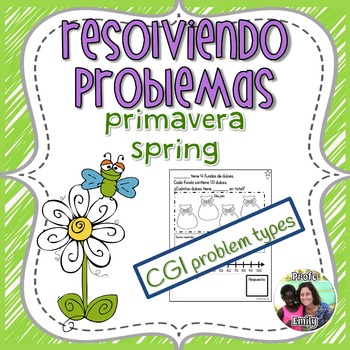Spanish Word Problems: Spring Addition & Subtraction | Bilingual | CGI
- Zip
What educators are saying
Also included in
- Back to School packet now includes Google Slides digital resource for distance learning! Engage your students in mathematical thinking and problem solving all year long with Spanish bilingual, differentiated word problems. Common Core aligned. Great for morning work or math centers. Students will prPrice $30.00Original Price $35.00Save $5.00
Description
Spanish Bilingual Word Problems - Spring themed - Problemas bilingües de primavera
Engage your students in mathematical thinking and problem solving with this packet of editable, bilingual, differentiated word problems! All problems are labeled with and align to CGI problem types. Great for morning work or math centers. (Laminate for durability.) Students will practice multiple addition and subtraction strategies including drawing a picture, part-part-whole, number lines, ten frames, and counting on! Numbers to 20.
Included:
☆ 24 spring themed word problems with text boxes to add your students' names!
☆ every problem labeled with CGI problem type
☆ multiple strategies to solve each problem
☆ 3 levels of differentiation
☆ English and Spanish problems and teacher instructions
Save money by buying the Resolviendo Problemas Bundle!
Followers and Feedback
Did you find this product useful? Click here to leave feedback on this product to earn TpT credit! You can also follow me for new products and updates - click on the green star!
Click here to get Spanish resources to teach classroom procedures and routines!
Thanks for downloading!
Profe Emily
☆☆☆☆☆☆☆☆☆☆☆☆☆☆☆☆☆☆☆☆☆☆☆☆☆☆☆☆☆☆☆☆☆☆☆☆☆☆☆☆☆
¡Problemas en palabras de primavera! ¡Ayuda a sus estudiantes desarrollar su pensamiento matemático con este paquete de problemas en palabras diferenciados, editables, y bilingües! Cada problema está etiquetada con y alineado a los tipos CGI. Perfecto para trabajo de la mañana o centros de matemáticas. (Plastificar para durabilidad.) Los estudiantes practican varias estrategias para sumar y restar, incluyendo dibujar, parte-parte-total, rectas numéricas, marcos de diez, y contar hacia adelante. Números hasta 20.
Incluído:
☆ 24 problemas en palabras del tema de primavera con cajas de texto - ¡entra los nombres de tus estudiantes!
☆ tipo CGI escrito en cada problema
☆ varias estrategias para resolver cada problema
☆ 3 niveles diferenciados por cada problema
☆ problemas e instrucciones en inglés y español
Haga clic aquí para conseguir más recursos de problemas en palabras.
Seguimiento y Comentarios
¿Le ha resultado útil este producto? Haga clic aquí para dejar comentarios para ganar créditos de TpT. También me puede seguir para saber de productos nuevos y actualizaciones - ¡haga clic en la estrella verde!
¡Haga clic aquí para encontrar recursos en español para enseñar rutinas y procedimientos del aula!
¡Gracias por descargar!
Profe Emily






